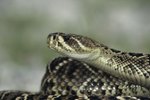Wash any boa constrictor (Boa constrictor spp.) bite with soap and warm water, and seek medical treatment if the bite will not stop bleeding or involves the eyes or mucous membranes. While they lack venom glands and fangs, boa constrictors have mouths full of sharp, teeth that curve toward the back of the mouth. These teeth can cause damage, but most lingering effects will come courtesy of the bacteria in your pet’s mouth.
Warnings
Because bites from large boa constrictors may be serious, pet keepers should never handle boas over 8 feet in length while alone.
The Boa's Mouth
Boas have homodont dentition, meaning their teeth are all similar in size and shape. They occur as six rows of teeth – one on each lower jawbone, one on each upper jawbone and two parallel teeth rows on the roof of the mouth. Because boa constrictors do not brush their teeth, they may carry a variety of bacteria in their mouths, such as Pseudomonas, Salmonella, and Klebsiella. Accordingly, it is imperative to cleanse any snakebite thoroughly and verify with your doctor that your tetanus vaccine is up to date.
The Spectrum of Bites
Not all boa constrictor bites are equally troubling. A defensive strike from a newborn boa is unlikely to break the skin, while a feeding bite from an adult may cause serious wounds -- particularly if the bite occurs to the eyes or face. Defensive strikes usually involve an open-mouthed “stabbing” followed by a rapid retreat, whereas boas clamp their jaws tightly and begin constricting when initiating a bite designed to capture prey. If your boa bites, but will not release, you can plunge him under cold water, which will often cause the snake to let go.
Basic First Aid
Serious bites -- meaning those that involve the eyes, mucous membranes or will not stop bleeding -- require medical attention, but you can treat minor bites yourself. After washing the bite, inspect the wound closely to ensure no teeth remain in the wound; remove any present with tweezers. Apply an over-the-counter antibiotic ointment or cream to the wound and cover it with a clean bandage. Seek immediate medical attention if you spot signs of infection, such as reddening, swelling or discharge from the wound. Minor bites from small boas are likely to heal in a day or two with little extra effort, while serious bites may require stitches and other measures.





